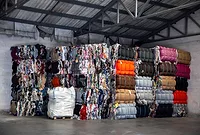Sustainable Proteins Can Partially Replace Latex in Carpet Coatings
WAGENINGEN, the Netherlands - In the transition to a circular economy, more and more companies are looking for sustainable alternatives to components made from fossil raw materials. One such company is EOC Belgium NV, which produces products including compounds for the carpet industry. Together with Wageningen Food & Biobased Research, EOC studied the properties of specific proteins and how they could be adapted to make them suitable for carpet coating applications.
The goal of the joint project between EOC and Wageningen Food & Biobased Research was to show that latex in carpet coatings, currently made from petroleum, can be partially replaced by protein fragments. This goal was achieved: the research proved that up to 20 percent can be replaced. During the project, Wageningen Food & Biobased Research focused on the chemical conversion process of the protein fragments in relation to the desired behavior (adhesive strength and binding) of the coating. The study used food-grade protein to determine the proof of principle, but the eventual goal is to work with proteins from residual streams such as grass and leaves.
Reducing Production Process Costs
Protein fragments were shown to have considerable potential as raw material for compounds produced by EOC, said Dirk Hoorne from the Belgian company, “EOC is specifically seeking ways of using biobased raw materials such as proteins and other sustainable streams. But we are realistic. The production process must become much cheaper to enable an economically profitable business case.” The project used relatively expensive food-grade proteins. Taking a next sustainable step will require proof that results can be achieved with proteins from residual streams.
Successful Partnership
“We enjoy working with Wageningen Food & Biobased Research,” said Hoorne. “They combine in-depth academic knowledge of substances such as proteins and how to adapt their properties to application requirements with an understanding of the economic reality. Our strength lies in having the expertise to formulate compounds for industrial applications. The blend of these assets has resulted in a very successful partnership in which we speak the same language and can easily make the required decisions.”
Methaform is an example of a project in which the two partners have achieved joint success. It focused on the further development of itaconic acid and methacrylic acid as building blocks for high-quality materials such as coatings, textile and glass.
Looking for a reprint of this article?
From high-res PDFs to custom plaques, order your copy today!






